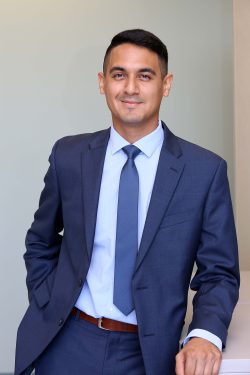 Michael A. Q. Martinez
Michael A. Q. Martinez
Education:
B.A. University of Bridgeport (2014)
Ph.D. Stony Brook University (2023)
Current Position:
9th Year MSTP
4th Year Medical Student
Advisor:
David Q. Matus
Graduate Program:
Molecular & Cellular Pharmacology
Research Interest:
According to the invasion/proliferation dichotomy (generally referred to as the “go versus grow” dichotomy), cell invasion and proliferation are mutually exclusive cell behaviors. However, evidence from studies on mouse models and cancer cell lines suggests that these cell behaviors can occur simultaneously following genetic and pharmacological perturbations of the cell cycle. In this dissertation, I investigate this dichotomy using the C. elegans anchor cell (AC) as a genetically dissectible single-cell model of cell invasion through basement membrane. Previous studies have demonstrated that the AC must be arrested in the G1/G0 phase of the cell cycle to invade. This process is mediated by several key regulators, including the evolutionarily conserved BAF subunit of the SWI/SNF chromatin remodeling complex and three conserved transcription factors: EGL-43 (EVI1), HLH-2 (E/Daughterless), and NHR-67 (TLX/Tailless). EGL-43 has been found to repress LIN-12 (Notch) expression to prevent AC proliferation, marking the first described mitogenic role for LIN-12 in C. elegans. NHR-67 was shown to regulate CKI-1 (p21/p27) expression to maintain the cell cycle arrested state of the AC. Here, I optimized two tools for use in C. elegans research: a CDK activity sensor and the auxin-inducible degron (AID) system. Using these tools, I determined that LIN-12 is not required for AC proliferation following EGL-43 loss and that CKI-1 is a critical negative regulator of the AC cell cycle. Furthermore, through direct perturbation of the AC cell cycle, I demonstrated that maintenance of the cell cycle arrested state is not necessary for AC invasion, breaking the previously established C. elegans invasion/proliferation dichotomy. Taken together, my dissertation work suggests that inhibiting both proliferation and invasion may be required to prevent the spread of metastatic cancer cells in the clinical setting.
Publications:
(*denotes co-first authors; ** denotes co-second authors)
Martinez, M.A.Q. and Matus, D.Q. (2024). Response to Correspondence: Hajnal et al. 'The role of lin-12 notch in C. elegans anchor cell proliferation'. Biology Open. 13(12): 1-3.
Martinez, M.A.Q., Zhao, C.Z., Moore, F.E.Q., Yee, C., Zhang, W., Shen, K., Martin, B.L., and Matus, D.Q. (2024). Cell cycle perturbation uncouples mitotic progression and invasive behavior in a post-mitotic cell. Differentiation. 137: 100765.
Medwig-Kinney, T.N., Kinney, B.A., Martinez, M.A.Q., Yee, C., Sirota, S.S., Mullarkey, A.A., Somineni, N., Hippler, J., Zhang, W., Shen, K., Hammell, C., Pani, A.M., and Matus, D.Q. (2023). Dynamic compartmentalization of the pro-invasive transcription factor NHR-67 reveals a role for Groucho in regulating a proliferative-invasive cellular switch in C. elegans. eLife. 12: RP84355.
Xiao, Y., Yee, C., Zhao, C.Z., Martinez, M.A.Q., Zhang, W., Shen, K., Matus, D.Q., and Hammell, C. (2023). An expandable FLP-ON::TIR1 system for precise spatiotemporal protein degradation in Caenorhabditis elegans. Genetics. 223(4): iyad013.
Maheshwari, R., Rahman, M.M., Drey, S., Onyundo, M., Fabig, G., Martinez, M.A.Q., Matus, D.Q., Müller-Reichert, T., and Cohen-Fix, O. (2023). A membrane reticulum, the centriculum, affects centrosome size and function in Caenorhabditis elegans. Current Biology. 33(5): 791-806.e7.
Martinez, M.A.Q., Mullarkey, A.A., Yee, C., Zhao, C.Z., Zhang, W., Shen, K., and Matus, D.Q. (2022). Reevaluating the relationship between EGL-43 (EVI1) and LIN-12 (Notch) during C. elegans anchor cell invasion. Biology Open. 11(12): bio059668.
Martinez, M.A.Q. and Matus, D.Q. (2022). CDK activity sensors: genetically encoded ratiometric biosensors for live analysis of the cell cycle. Biochemical Society Transactions. 50(3): 1081-1090
Martinez, M.A. (2022). Do I Belong? JCO Oncology Practice. 18(5): 378-379.
Smith, J.J., Xiao, Y., Parsan, N., Medwig-Kinney, T.N., Martinez, M.A.Q., Moore, F.E.Q., Palmisano, N.J., Kohrman, A.Q.,Chandhok Delos Reyes, M., Adikes, R.C., Liu, S., Bracht, S.A., Zhang, W., Wen, K., Kratsios, P., and Matus, D.Q. (2022). The SWI/SNF chromatin remodeling assemblies BAF and PBAF differentially regulate cell cycle exit and cellular invasion in vivo. PLoS Genetics. 18(1): e1009981.
Hills-Muckey, K., Martinez, M.A.Q., Stec, N., Hebbar, S., Saldanha, J., Medwig-Kinney, T.N., Moore, F.E.Q., Ivanova, M., Morao, A., Ward, J.D., Moss, E.G., Ercan, S., Zinovyeva, A.Y., Matus, D.Q., and Hammell, C.M. (2022). An engineered, orthogonal auxin analog/AtTIR1(F79G) pairing improves both specificity and efficacy of the auxin degradation system in Caenorhabditis elegans. Genetics. 220(2): iyab174.
Ashley, G., Duong, T.**, Levenson, M.T.**, Martinez, M.A.Q.**, Johnson, L.C., Hibshman, J.D., Saeger, H.N., Palmisano, N.J., Doonan, R., Martinez-Mendez, R., Davidson, B., Zhang, W., Ragle, J.M., Medwig-Kinney, T.N., Sirota, S.S., Goldstein, B., Matus, D.Q., Dickinson, D.J., Reiner, D.J., and Ward, J.D. (2021). An expanded auxin-inducible degron toolkit for Caenorhabditis elegans. Genetics. 217(3): iyab006.
Adikes, R.C.*, Kohrman, A.Q.*, Martinez, M.A.Q.*, Palmisano, N.J., Smith, J.J., Medwig-Kinney, T.N., Min, M., Sallee, M.D., Ahmed, O.B., Kim, N., Liu, S., Morabito, R., Weeks, N., Zhao, Q., Zhang, W.,Feldman, J., Barkoulas, M., Pani, A.M., Spencer, S.L., Martin, B.L., and Matus, D.Q. (2020). Visualizing the metazoan proliferation-quiescence decision in vivo. eLife. 9: e63265.
Martinez, M.A.Q. and Matus, D.Q. (2020). Auxin-mediated protein degradation in Caenorhabditis elegans. Bio-protocol. 10(8): e3589.
Martinez, M.A.Q., Kinney, B.A., Medwig-Kinney, T.N., Ashley, G., Ragle, J.M., Johnson, L., Aguilera, J., Hammell, C.M., Ward, J.D., and Matus, D.Q. (2020). Rapid degradation of Caenorhabditis elegans proteins at single-cell resolution with a synthetic auxin. G3: Genes, Genomes, Genetics. 10(1): 267-280.
Penfield, L., Wysolmerski, B., Mauro, M., Farhadifar, R., Martinez, M.A., Biggs, R., Wu, H.Y., Broberg, C., Needleman, D., and Bahmanyar, S. (2018). Dynein-pulling forces counteract lamin-mediated nuclear stability during nuclear envelope repair. Molecular Biology of the Cell. 29(7): 852-868.
Chow, R.D., Guzman, C.D., Wang, G., Schmidt, F., Youngblood, M.W., Ye, L., Errami, Y., Dong, M.B., Martinez, M.A., Zhang, S., Renauer, P., Bilguvar, K., Gunel, M., Sharp, P.A., Zhang, F., Platt, R.J., and Chen, S. (2017). AAV-mediated direct in vivo CRISPR screen identifies functional suppressors in glioblastoma. Nature Neuroscience. 20(10): 1329-1341.

